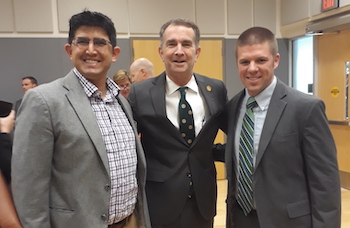
A 3D printed coil used to search for quantum resonances in materials. Photo provided.
The growth in quantum materials technology figures to play prominently in our nation’s future, and George Mason University’s Quantum Materials Center (QMC) plans to help that process along.
The primary goal of the center, which opened last fall, is to develop a unified approach to materials discovery and exploration for the realization of advanced quantum electronics technologies. One of Mason’s Transdisciplinary Centers for Advanced Study supported by the Provost’s Office, the center relies on the expertise of 14 Mason scientists from the fields of physics, mathematics, electrical engineering, mechanical engineering and computer science.
“For materials science to really advance, you need to adopt a transdisciplinary approach,” said QMC director Patrick Vora, an assistant professor in the Department of Physics and Astronomy within the College of Science. “You need to have quantum physicists interacting with engineers, with computer scientists, and with mathematicians. You need to have collaborations between experimentalists who are experts in different kinds of techniques. Only by examining a material from many perspectives can you really understand it and how it can be used to make new electronic devices that surpasses the current state-of-the-art.”

QMC director Patrick Vora, Gov. Ralph Northam, and Chris Boies, Mason's assistant vice president, business services, Facilities, during a Mason tour last week. Photo provided.
Using their expertise in artificial intelligence, topological quantum theory, nanophotonics, materials growth and numerous experimental characterization techniques, the team aims to realize several computationally designed quantum materials that can be incorporated in new “Beyond Moore” computing architectures and quantum sensing technologies. Devices operating on quantum material substrates could provide substantial reductions in energy consumption while simultaneously increasing performance. The absence of materials that exhibited robust quantum properties is the primary limiting factor in efforts by the scientific and engineering communities.
“We want to find materials with strong quantum properties using machine learning and artificial intelligence to increase discovery rate,” Vora said.
That technology could prove especially beneficial in the development of faster, more efficient computers, as well as quantum computers that are exponentially faster than their conventional counterparts at certain problems. Additionally, quantum materials can provide a basis for a new type of encryption based on quantum states that is fundamentally unbreakable.
National security implications also apply to quantum sensing, in particular to a quantum sensor to detect magnetic fields with extreme sensitivity at room temperature. Quantum sensing promises to potentially revolutionize the military by providing highly accurate positioning data to detecting the exact location of explosives in all types of environments.
“We keep getting smaller,” said Karen Sauer, a professor within the Department of Physics and Astronomy and expert in quantum sensing. “As we get smaller, we’ve entered the quantum realm. We need to use materials that harness these quantum properties to make new breakthroughs.”
The QMC’s four main areas of quantum materials research focus are design, exploration, creation and education. Students or faculty interested in learning more or working with the QMC should email qmc@gmu.edu.
